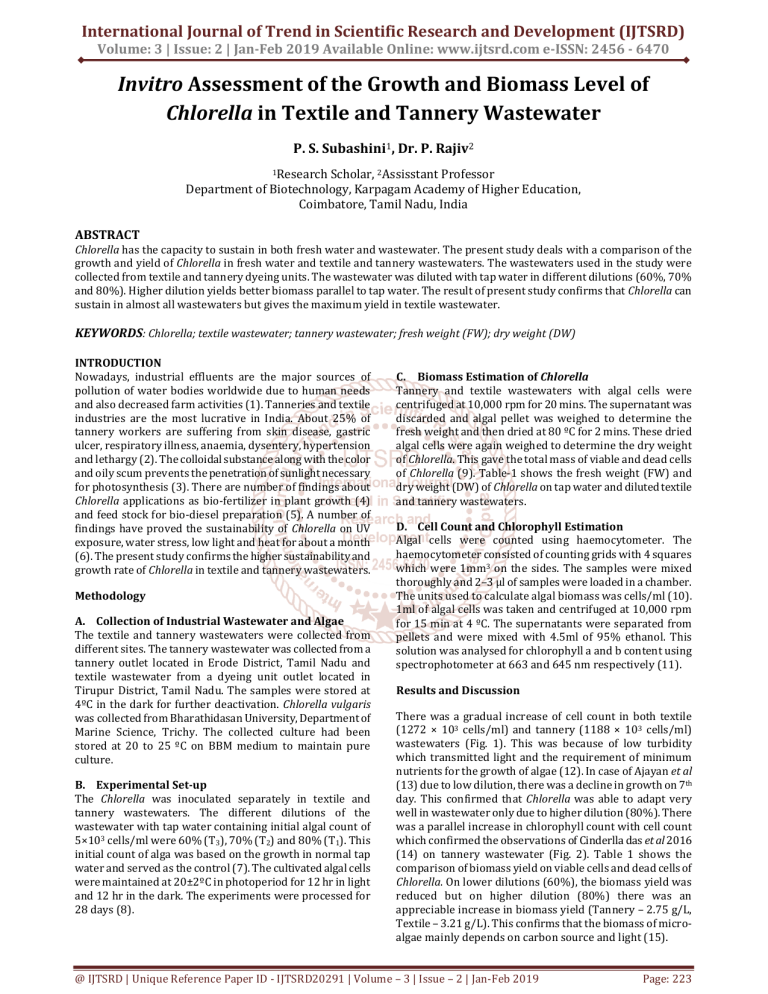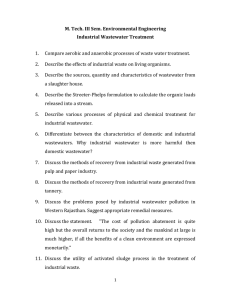
International Journal of Trend in Scientific Research and Development (IJTSRD)
Volume: 3 | Issue: 2 | Jan-Feb 2019 Available Online: www.ijtsrd.com e-ISSN: 2456 - 6470
Invitro Assessment of the Growth and Biomass Level of
Chlorella in Textile and Tannery Wastewater
P. S. Subashini1, Dr. P. Rajiv2
1Research
Scholar, 2Assisstant Professor
Department of Biotechnology, Karpagam Academy of Higher Education,
Coimbatore, Tamil Nadu, India
ABSTRACT
Chlorella has the capacity to sustain in both fresh water and wastewater. The present study deals with a comparison of the
growth and yield of Chlorella in fresh water and textile and tannery wastewaters. The wastewaters used in the study were
collected from textile and tannery dyeing units. The wastewater was diluted with tap water in different dilutions (60%, 70%
and 80%). Higher dilution yields better biomass parallel to tap water. The result of present study confirms that Chlorella can
sustain in almost all wastewaters but gives the maximum yield in textile wastewater.
KEYWORDS: Chlorella; textile wastewater; tannery wastewater; fresh weight (FW); dry weight (DW)
INTRODUCTION
Nowadays, industrial effluents are the major sources of
pollution of water bodies worldwide due to human needs
and also decreased farm activities (1). Tanneries and textile
industries are the most lucrative in India. About 25% of
tannery workers are suffering from skin disease, gastric
ulcer, respiratory illness, anaemia, dysentery, hypertension
and lethargy (2). The colloidal substance along with the color
and oily scum prevents the penetration of sunlight necessary
for photosynthesis (3). There are number of findings about
Chlorella applications as bio-fertilizer in plant growth (4)
and feed stock for bio-diesel preparation (5). A number of
findings have proved the sustainability of Chlorella on UV
exposure, water stress, low light and heat for about a month
(6). The present study confirms the higher sustainability and
growth rate of Chlorella in textile and tannery wastewaters.
Methodology
A. Collection of Industrial Wastewater and Algae
The textile and tannery wastewaters were collected from
different sites. The tannery wastewater was collected from a
tannery outlet located in Erode District, Tamil Nadu and
textile wastewater from a dyeing unit outlet located in
Tirupur District, Tamil Nadu. The samples were stored at
4ºC in the dark for further deactivation. Chlorella vulgaris
was collected from Bharathidasan University, Department of
Marine Science, Trichy. The collected culture had been
stored at 20 to 25 ºC on BBM medium to maintain pure
culture.
B. Experimental Set-up
The Chlorella was inoculated separately in textile and
tannery wastewaters. The different dilutions of the
wastewater with tap water containing initial algal count of
5×103 cells/ml were 60% (T3), 70% (T2) and 80% (T1). This
initial count of alga was based on the growth in normal tap
water and served as the control (7). The cultivated algal cells
were maintained at 20±2ºC in photoperiod for 12 hr in light
and 12 hr in the dark. The experiments were processed for
28 days (8).
C. Biomass Estimation of Chlorella
Tannery and textile wastewaters with algal cells were
centrifuged at 10,000 rpm for 20 mins. The supernatant was
discarded and algal pellet was weighed to determine the
fresh weight and then dried at 80 ºC for 2 mins. These dried
algal cells were again weighed to determine the dry weight
of Chlorella. This gave the total mass of viable and dead cells
of Chlorella (9). Table-1 shows the fresh weight (FW) and
dry weight (DW) of Chlorella on tap water and diluted textile
and tannery wastewaters.
D. Cell Count and Chlorophyll Estimation
Algal cells were counted using haemocytometer. The
haemocytometer consisted of counting grids with 4 squares
which were 1mm3 on the sides. The samples were mixed
thoroughly and 2–3 µl of samples were loaded in a chamber.
The units used to calculate algal biomass was cells/ml (10).
1ml of algal cells was taken and centrifuged at 10,000 rpm
for 15 min at 4 ºC. The supernatants were separated from
pellets and were mixed with 4.5ml of 95% ethanol. This
solution was analysed for chlorophyll a and b content using
spectrophotometer at 663 and 645 nm respectively (11).
Results and Discussion
There was a gradual increase of cell count in both textile
(1272 × 103 cells/ml) and tannery (1188 × 103 cells/ml)
wastewaters (Fig. 1). This was because of low turbidity
which transmitted light and the requirement of minimum
nutrients for the growth of algae (12). In case of Ajayan et al
(13) due to low dilution, there was a decline in growth on 7th
day. This confirmed that Chlorella was able to adapt very
well in wastewater only due to higher dilution (80%). There
was a parallel increase in chlorophyll count with cell count
which confirmed the observations of Cinderlla das et al 2016
(14) on tannery wastewater (Fig. 2). Table 1 shows the
comparison of biomass yield on viable cells and dead cells of
Chlorella. On lower dilutions (60%), the biomass yield was
reduced but on higher dilution (80%) there was an
appreciable increase in biomass yield (Tannery – 2.75 g/L,
Textile – 3.21 g/L). This confirms that the biomass of microalgae mainly depends on carbon source and light (15).
@ IJTSRD | Unique Reference Paper ID - IJTSRD20291 | Volume – 3 | Issue – 2 | Jan-Feb 2019
Page: 223
International Journal of Trend in Scientific Research and Development (IJTSRD) @ www.ijtsrd.com eISSN: 2456-6470
Figure 1; Cell count on textile and tannery wastewater (cell count/ml)
Figure 2; Chlorophyll estimation on textile and tannery wastewater (µg/ml)
(a) Chlorophyll a on tannery effluent
(b) Chlorophyll b on tannery effluent
(c) Chlorophyll a on textile effluent
(d) Chlorophyll b on textile effluent
TABLE 1 Biomass estimation of Chlorella on textile and tannery wastewater
Fresh weight of Chlorella before and after treatment (g/L)
Dry weight of Chlorella before and after
treatment (g/L)
1st day
7th day
14th day
21st day
28th day
1st day
7th day
14th day
21st day
28th day
Tap water
0.85
1.99
3.38
4.25
5.63
0.28
1.05
2.29
3.18
4.23
Dilutions
1st day
28th day
1st day
Textile wastewater
7th day 14th day 21st day
28th day
T1-80%
T2-70%
T3-60%
0.25
0.25
0.25
3.21
2.86
2.06
0.10
0.10
0.10
0.53
0.31
0.18
2.45
1.78
1.20
Dilutions
1st
28th
1st
7th
T1-80%
0.25
0.79
1.09
1.95
2.75
0.10
0.46
0.86
1.22
1.98
T2-70%
T3-60%
0.25
0.25
0.51
0.33
0.93
0.66
1.36
0.97
1.91
1.30
0.10
0.10
0.33
0.17
0.63
0.35
0.87
0.59
1.36
0.97
Textile wastewater
7th day 14th day 21st day
0.86
0.61
0.42
1.33
1.12
0.77
2.58
1.76
1.28
Tannery wastewater
day 7th day 14th day 21st day
day
day
0.98
0.72
0.57
1.61
1.22
0.81
Tannery wastewater
day 14th day 21st day
@ IJTSRD | Unique Reference Paper ID - IJTSRD20291 | Volume – 3 | Issue – 2 | Jan-Feb 2019
28th day
Page: 224
International Journal of Trend in Scientific Research and Development (IJTSRD) @ www.ijtsrd.com eISSN: 2456-6470
Acknowledgement
We thank Department of Marine Science, Bharathidasan
University for providing us the algal culture Chlorella
vulgaris. Due to this help, we were able to start bioremediation research and completed successfully.
References
[1] V. Diagomanolin, M. Farhang, M. Ghazi-khansari, and N.
Jafarzadeh, “Heavy metals (Ni, Cr, Cu) in the Karoon
waterway river, Iran”, Toxicol. Lett, vol. 151, pp. 63-67,
2004.
[2] M.K. Mohanta, A.K. Saha, and M.A. Hasan, “Prevalence
and determination of occupational diseases of leather
tannery workers”, Univ. j. zool. Rajshahi. Univ, vol. 31,
pp. 79-82, 2012.
[3] Rita Kant, “Textile dyeing industry an environmental
hazard”, Nat. Sci, vol. 4, pp. 22-26, 2012.
[4] N.H. Brahmbhatt and S.K. Haresh, “Effect of algae on
seedling growth of “Queen of Forages”, IJERGS, vol. 3,
pp. 827-833, 2015.
[5] Y. Chisti, “Biodiesel from microalgae”, Biotech. Adv, vol.
25, pp. 294-306, 2007.
[6] S.C. Agrawal and V. Singh. “Viability of dried cells, and
survivability and reproduction under water stress, low
light, heat, and UV exposure in Chlorella vulgaris”, ISR.
J. Plant. Sci. J, vol. 49, pp. 27-32, 2001.
[7] Y. Sanjay and G.P. Satsangi, “Allelopathic effect of algal
leachates on seed germination and seedling growth of
Paddy”, J. Algal. Biomass. Util, vol. 5, pp. 80-84, 2014.
[8] K.V. Ajayan and M. Selvaraju, “Phycoremediation of
tannery wastewater using microalgae Scenedesmus
species”, Int. J. Phytoremediation, vol. 17, pp. 907-916,
2015.
[9] Y. Li, X. Fei and X. Deng, “Novel molecular insights into
nitrogen
starvation
induce
triacylglycerols
accumulation revealed by differential gene expression
analysis in green algae Micractinium pusillum”,
Biomass. Bioener. Vol. 42, pp. 199-211, 2012.
[10] Lenore S Clesceri, Standard Methods for the
Examination of Water and Wastewater, American
Public Health Association, 20th ed., Washington DC:
USA, 1998.
[11] S. Nayek, I.H. Choudhury, N. Jaishee and S. Roy,
“Spectrophotometric analysis of chlorophylls and
carotenoids from commonly grown fern species by
using various extracting solvents”, Res. J. Chem. Sci, vol.
4, pp. 63-69, 2014.
[12] E.E. Nour Eldeen, M.A. Zayed, K.A. Rabie and M.E.
Moattassem, “The seasonal variation of the Nile water
quality”, J. Environ. Sci. Heal A, vol. 30, pp. 1957-1972,
1995.
[13] K.V. Ajayan, M. Selvaraju, P. Unnikannan and P. Sruthi,
“Phycoremediation of tannery wastewater using
microalgae
Scenedesmus
species”,
Int.
J.
Phytoremediation, vol. 17, pp. 907-916, 2015.
[14] D. Cindrella, K. Naseera, Anirudh Ram, Ram Murti
Meena and R. Nagappa, Bioremediation of tannery
wastewater by a salt-tolerant strain of Chlorella
vulgaris, J. Appl. Phycol, 2016.
[15] A. Richmond, Handbook of microalgal culture:
biotechnology and applied phycology. Blackwell
Science Ltd, 2004.
@ IJTSRD | Unique Reference Paper ID - IJTSRD20291 | Volume – 3 | Issue – 2 | Jan-Feb 2019
Page: 225



